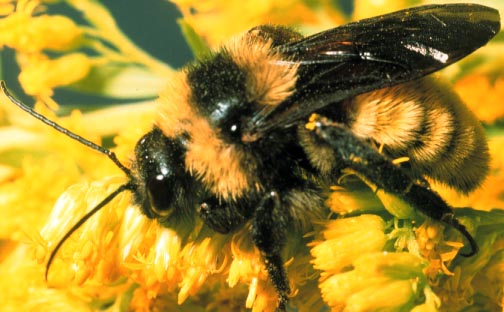| Bumble Bees
Bumble bees are big, fuzzy insects recognized by almost everyone by their robust shape and black and yellow coloration. The common species are 3/4 inch in length or more. Like honey bees, bumble bees live in a colony where the adults care for the young (larvae) produced by a single queen. Bumble bee nests are small compared to honey bees, as each nest contains only a few hundred individuals. Also, unlike honey bees, a bumble bee nest is annual and is used only one year and then abandoned. Bumble bees may re-appear in the same area from one year to the next but they do not reuse an old nest. Bumble bee colonies are usually underground in a deserted mouse or bird nest though they are occasionally found within wall cavities or even in the clothes drier vent.
In the spring, each new queen selects a nest site and starts a new colony. She lines the cavity with dry grass or moss and then collects pollen and nectar to produce a stored food called "bee bread." Her first brood of offspring, (5 to 20), will all be workers (daughters) who take over the colony responsibilities of nest enlargement, food gathering and storage, and feeding and caring for the larvae. The queen continues to lay eggs throughout the summer. By late summer, new reproductive males and females (kings and queens) are produced. These mate on the wing and the fertilized females move to hibernation sites in the shelter of loose bark, hollow trees or other dry, protected places to lie dormant through the winter. The males and workers still in the colony die with frost or the first hard freeze.
If the vicinity of a bumble bee nest can be avoided, then leave them alone and wait for them to die in the fall as the preferred "management" option. Live-trapping bumble bees for relocation is not practical and covering the nest entrance does not usually solve the problem.
Bumble bee nests in yards, flowers beds, wood piles, walls or other high traffic areas may create an unacceptable threat of being stung and justify treatment. Determine the exact location of the nest entrance from a safe distance during the day, but wait until night to treat if possible. Wear long-sleeved shirt and trousers and tie sleeves and pants legs shut or pull your socks out over your pant cuffs.
Apply an insecticide dust labeled for outdoor use against bees through the entrance hole. Use a duster or squeeze bottle to puff the insecticide into the opening, or to "fling" the insecticide into the hole off an old plastic spoon. Cover underground nest openings with soil but do not plug nests in house walls until all activity has stopped. Be prepared to repeat the treatment if necessary. Repair wall nesting sites with caulk and paint. |

